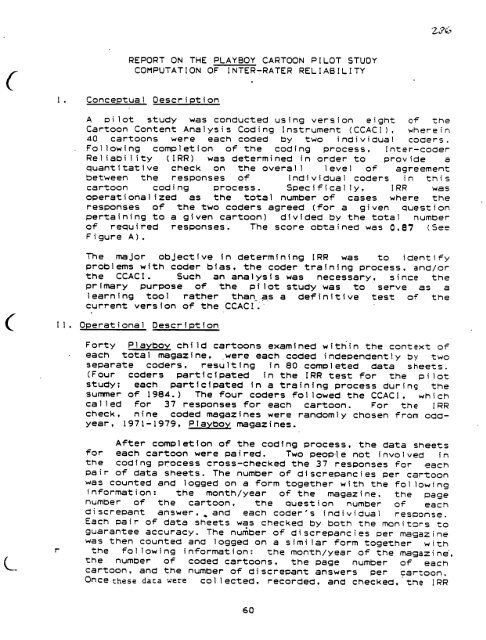l I - National Criminal Justice Reference Service
l I - National Criminal Justice Reference Service
l I - National Criminal Justice Reference Service
Create successful ePaper yourself
Turn your PDF publications into a flip-book with our unique Google optimized e-Paper software.
REPORT ON THE PLAYBOY CARTOON PILOT STUOY<br />
COMPUTATION OF INTER-RATER RELIABILITY<br />
I. Conceptual Description<br />
A pilot study was conducted using version eight oF the<br />
Cartoon Content Analysis Coding Instrument (CCACI), wherein<br />
40 cartoons were each coded ~y two indiviOual coders.<br />
Following completion of the coding process, Inter-coOer<br />
Reliability (IRR) was determined in order to proviOe a<br />
quantitative check on the overall level of agreement<br />
~etween the responses of individual coders in this<br />
cartoon coding process. Specifically, IRR was<br />
operationalized as the total number of cases where the<br />
responses of the two coders agreed (for a given question<br />
pertainlng to a given cartoon) divided by the total number<br />
of required responses. The score o~tained was 0.87 (See<br />
Figure A).<br />
The major objective in determining IRR was to identify<br />
problems with coder bias, the coder training process, and/or<br />
the CCACI. Such an analysis was necessary, since the<br />
primary purpose of the pilot study was to serve as a<br />
learning tool rather than..as a definitive test of the<br />
current version of the CCACI.<br />
II. Operational Description<br />
Forty Playboy child cartoons examined within the context of<br />
each total magazine, were each coded independently by two<br />
separate coders, resulting in 80 completed data sheets.<br />
(Four coders participated in the IRR test for the pilot<br />
study; each participated In a training process during the<br />
summer of 1984.) The Four coders followed the CCACI, which<br />
called for 37 responses for each cartoon. For the IRR<br />
check, nine coded magazines were randomly chosen from oaOyear,<br />
1971-1979, Playboy magazines.<br />
L<br />
After completion of the coming process, the data sheets<br />
for each cartoon were paired. Two people not invoIve~ in<br />
the coding process cross-checke~ the 37 responses for each<br />
pair of data sheets. The number o4 discrepancies per cartoon<br />
was counted and logged on a form together with the following<br />
information: the month/year o4 the magazine, the page<br />
number o4 the cartoon, the question number of each<br />
discrepant answer,, and each coder's indiviOual response.<br />
Each pair o4 data sheets was checked by both the monitors So<br />
guarantee accuracy. The number of discrepancies per magazine<br />
was then counted and logged on a similar form together with<br />
the following information: the month/year of the magazine,<br />
the number o4 codeO cartoons, the page number o4 each<br />
cartoon, and the number of discrepant answers per cartoon.<br />
Once these data ~ere collecteO, recor~e~, and checkeO, the IRR<br />
60
















